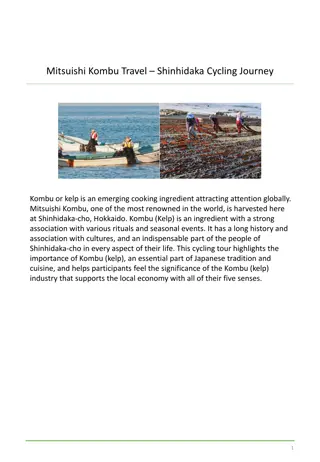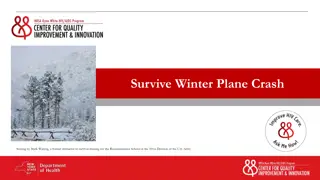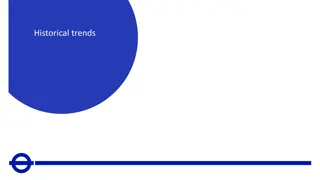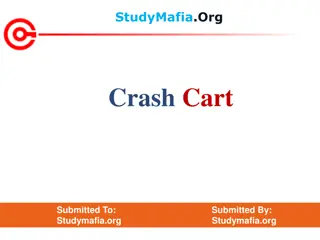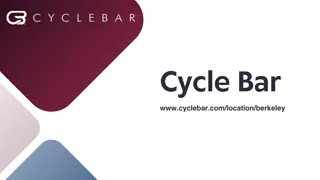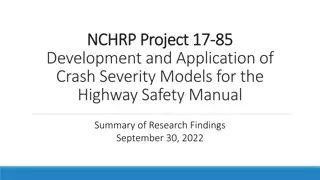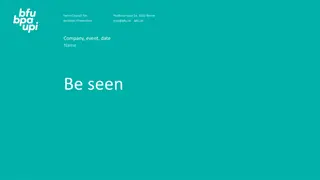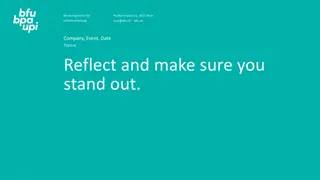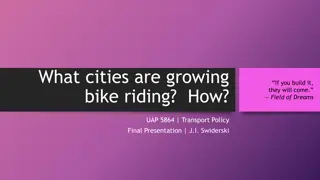Cycling Crash Prevention Tips and Guidelines
Learn about different types of cycling crashes, common auto-bike accidents, basic rules of accident prevention, and how to handle cyclist-dog encounters. Discover strategies to avoid collisions, falls, and stay safe on the road.
Download Presentation

Please find below an Image/Link to download the presentation.
The content on the website is provided AS IS for your information and personal use only. It may not be sold, licensed, or shared on other websites without obtaining consent from the author. Download presentation by click this link. If you encounter any issues during the download, it is possible that the publisher has removed the file from their server.
E N D
Presentation Transcript
CYCLING CRASH PREVENTION Pages 40-42
PERFORMANCE OBJECTIVES 1. List the two types of cycling crashes. 2. Name the most common auto bike accident 3. List the four types of falls. 4. Discuss the cyclist dog accident and describe the appropriate steps to take to avoid a dog.
PERFORMANCE OBJECTIVES 5. Cite the three basic rules of accident prevention. 6. Discuss the bicyclist rights and responsibilities
Two types of bicycle crashes 1.Collisions 2.Falls
THREE MOST COMMON AUTO-BIKE CRASHES 1.THE LEFT TURN CRASH - motorist turns left in front of the oncoming cyclist (MOST COMMON). 2.THE RIGHT TURN AFTER PASSING CRASH - motorist passes the cyclist then immediately turns right. 3.VEHICLE DOORS BEING OPENED IN THE PATH OF THE CYCLIST stay out of the door zone!
AUTO-BIKE COLLISIONS ACCOUNT FOR ONLY 10-18% OF ALL CYCLING CRASHES. TEND TO BE MORE SERIOUS . FOR OBVIOUS REASONS. RURAL ACCIDENTS TEND TO BE MORE FATAL. Why?
FOUR TYPES OF FALLS 1. SKIDDING - WHEN THE TIRES LOSE SIDEWAYS TRACTION AND THE BIKE SLIDES ON ITS SIDE. CAUSES: WET ROADS, GRAVEL, SAND, SLIPPERY SURFACES AND PAINTED AREAS (lines) 2. STOPPING - WHEN THE BIKE SUDDENLY STOPS MOVING FORWARD . CAUSES: POTHOLES, STREET GRATES, CURBS AND USING THE BRAKES TO HARD
FALLS - CONT. 3.DIVERTING - WHEN THE BIKE STEERS OUT FROM UNDER THE CYCLIST. CAUSES: DIAGONAL RR TRACKS, EXPANSION JOINTS, MANHOLE COVERS AND RAISED LANES MARKERS 4.INSUFFICIENT SPEED - WHEN THE CYCLIST SLOWS DOWN AND LOSES BALANCE. CAUSES: FAILURE TO GET FOOT DOWN OR FALLS TO THE OPPOSITE SIDE THAT THE FOOT IS DOWN
BICYCLIST-DOG CRASH 1.Turn into the dogs vector. If the dog is coming on an intercepting course, turn into its vector and it will likely change directions. 2.Squirt the dog with your water bottle. 3.Blow your whistle or yell at him. 4.Use pepper spray. (MUST BE approved by your departments Use of Force Policy). 5. Slow down, then speed up. Changes the dogs angle of pursuit.
EXIT THE ALLEY CRASH Very common in congested areas. Either the auto or bicyclist does not stop and a crash occurs. Most alleys have large blind stops.
BIKE-BIKE COLLISIONS Generally caused by the cyclist operating in the wrong road position or in the wrong direction. Many occur in the racing environment. Officers riding together to a call have been known to collide.
BIKE OFFICER VS. PATROL CAR CRASH Happens more often than you think Usually involves two officers responding to the same emergency call and they each think they have the right of way. "I m the police and its an emergency I have the right of way!" The other officer thinks this TOO!!!! Don t get tunnel vision Communication is key to keeping this from happening
ACCIDENT PREVENTION The three basic rules of cyclist accident prevention: 1.Be seen 2.Be predictable 3.Be paranoid
ACCIDENT PREVENTION Be Seen 1. Wear reflective clothing 2. Make sure bikes are equipped with lights and reflectors 3. Make eye contact with drivers to make sure you are seen 4. Use a whistle to get their attention
ACCIDENT PREVENTION Be predictable 1. Signal if you want to turn. If you signal, turn 2. Do not challenge vehicles, especially those who drive for a living such as cabs and delivery trucks 3. Maintain your position in traffic by limiting the number of times that you merge with traffic 4. Stay straight, not weaving
ACCIDENT PREVENTION Be paranoid 1. Anticipate that the driver is going to pull out in front of you or cut you off 2. Have a plan 3. Look through rear windows for drivers who might open doors 4. Watch for brake lights, turned wheels and anything that might indicate trouble
BICYCLIST RIGHTS The bicyclist has the right to ride on any state maintained road, except roads of the Interstate Highway system and other fully-controlled access highways (exceptions do apply). While the bicyclist should ride as far to the right as practicable, a bicyclist may ride well out in the lane of traffic under the following conditions: if the rider can maintain the same speed as other vehicles on the roadway if the right-hand edge of the roadway is in poor condition or is littered with debris
BICYCLIST RIGHTS-CONT. A bicyclist is not required to ride on the shoulder, since the shoulder is not legally defined as part of the roadway. A bicyclist may choose to make a left turn from the appropriate lane, like a vehicle, or may dismount and walk the bike across the intersection, like a pedestrian.
BICYCLISTS RESPONSIBILITIES Ride on the right, in the same direction as other moving traffic. (Law in all 50 states) Obey all traffic signs and signals, including stop and yield signs and one- way directional signs. Use signals to communicate intended movements.
BICYCLISTS RESPONSIBILITY- CONT. Yield to pedestrians and emergency vehicles. Equip the bicycle with a lamp that has a white light visible at least 500 feet to the front and a lamp and a reflector displaying a red light visible from 600 feet to the rear at night. Bicyclist should ride predictably and courteously to keep traffic moving safely and to avoid accidents.
MOTORIST RESPONSIBILITY Cars must pass bikes safely. Many states have a 3 foot rule. Must allow three feet clearance and not move back to the right until it is safe to do so.
PERFORMANCE OBJECTIVES-REVIEW 1.List at least four types of cycling crashes. 2.List the four types of falls. 3.Name the most common auto bike accidents. 4.Discuss the cyclist dog accident and describe the appropriate steps to take to avoid a dog.
PERFORMANCE OBJECTIVES-REVIEW 5.Cite the three basic rules of accident prevention. 6.Discuss the bicyclist rights and responsibilities

 undefined
undefined

